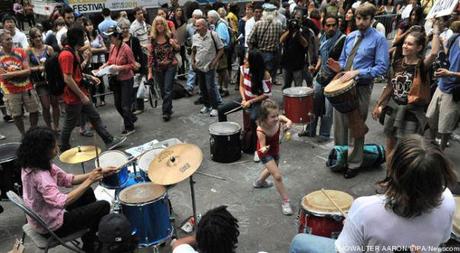
A drum circle ... great.
It’s not difficult for me to remember my first impression of Occupy Wall Street. Like many a New Yorker, mine was one of curiosity and cautious, yet hard to repress delight. For all the criticism regarding a lack of central message, the truth is that there was and continues to be one key point of agreement among all the protesters: things as they are are not good enough, and that’s a hard message to deny from any side of the political spectrum.
Happily I went, and quickly I was disappointed. It was a weekday afternoon, which meant that it was down to the most dedicated, most permanent protesters, maybe two hundred, and every negative stereotype regarding their appearance and attitude was given comical and exaggerated life. The crowd was almost entirely young, white, and, despite the mildly reassuring presence of showers and well-used trash receptacles, diseased looking. Every worthwhile message was cheerfully conveyed on the shittiest looking pissed-on cardboard to be found, and the one activity that drew the most energy, most participation, and most observation was the drum circle. I fucking hate drum circles.
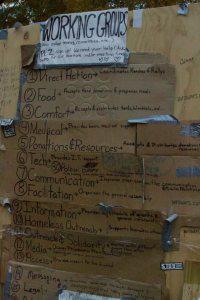
The fucking centerpiece of the protest.
It was time to take a breath. I stopped and read the literature. I listened to conversations, and spoke to a few of the many helpful, intelligent participants. For the time being, my fears had been eased. The package wasn’t perfect, but it was the right message for the right time. Better to have them there than not.
Weeks later, my now editor Jon Morris and I traveled to Philadelphia and explored the Occupy Philly protests taking place in front of City Hall. There we found a group of similar size to Occupy Wall Street, but with more space and a more visibly organized appearance far more welcoming to newcomers. And aside from goals particular to the state of Pennsylvania, the message and presentation was essentially the same. The theme for that day had been how to dump your big bank and switch to a smaller name or credit union.
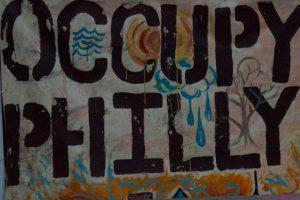
My feeling walking through the avenues of camping gear was once again one of annoyance, but this time not at the protesters. A couple of suits were also passing through, and the protest’s appearance prompted one to scoff and ask, “Can you believe this?” I honestly believed, somewhat naively, that anyone who actually took the time to come to the protest would have a reappraisal similar to my own. But no, this is America. And in this country, probably the most media soaked nation outside of the UK, we gladly shoot the messenger.
In an undoubtedly deliberate attempt to further prove how silly I had been, local police have since clamped down hard on the protesters. From Oakland and Seattle to New York, Philly and LA, police armored in black and blue riot gear have swept through the camps and ousted the occupants in a flurry of arrests, punches, kicks and pepper sprays. Some were gentler than others, but all essentially succeeded in their shared, ultimate goal: breaking the back of the movement.
That doesn’t necessarily mean the end of it all, but it’s a move that has taken the edge out of the day to day reports on the protests, especially as media platforms make more room for the Republican presidential nomination. And with the actual presidential election in less than a year’s time, it’s only going to become more difficult for OWS to reclaim the media saturation it enjoyed as little as one month ago. Gandhi said that the first reaction from the powers that be on the road to revolution is to ignore, and OWS is dangerously close to being ignored once again[1].
So now I’m left with the question: how did it come to this? It’s easy, and right, to throw blame at the leaders and institutions that have facilitated the financial corruption, the silencing of free speech and, in some cases, the police brutality. But that doesn’t change the fact that, given this nation’s economic imbalance, the violent dispersal of the protests should have been a public relations disaster for all state and local officials involved[2]. Instead, the most critical media analysis so far is that the use of pepper spray by police had been unwarranted, maybe.
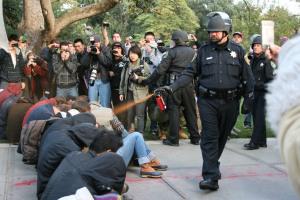
Pictured: ambiguity
Parts of the answer to my question have come from the early 70’s. Emerging from the 60’s was an American generation caught between political forces against which it was tempting to feel helpless, especially when the media seemed so collusive with those forces. But it was still the era of radical protest, and one book, a practical guide on how to achieve change from the bottom up, was published by one of the masters of the form in 1971.
Rules for Radicals was written by Saul Alinsky, the father of modern day community organizing. He had made his name by working to improve living conditions of low income African American neighborhoods in Illinois, California, Michigan and New York through grassroots political activism in the 50’s and 60’s. When faced with the youth protest movements of the latter decade, often borrowing from his own strategies, he was compelled to write a handbook to help what he often saw as amateurish attempts to effect institutional change.
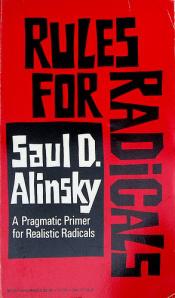
Having only recently read the book for the first time, it’s hard for me to not draw connections from the text to the current situation with OWS. One of the first points Alinsky goes through great pains to make is the absolute necessity for radicals and revolutionaries to consider how their message is received. And this is what he saw as the primary failure of many youth protest movements.
“This failure of many of our younger activists to understand the art of communication has been disastrous. Even the most elementary grasp of the fundamental idea that one communicates within the experiences of his audience – and gives full respect to the other’s values – would have ruled out attacks on the American flag.” (Alinsky xviii, 1971)
While there have yet to be any flag burnings like the ones to which Alinsky was referring, I now look back on my initial encounters in Zuccotti Park and realize that I should have sustained my more critical reactions. I am what you’d call a dyed in the wool liberal, and I would be hard pressed to find any ideological stance among the protestors with which I strongly disagree. And yet despite the overlap, my first response was still one of alienation and, worse yet, patronizing amusement. If I needed to overcome that many psychological barriers to find my ultimate support for the cause, then who knows that what your typical working class middle-American must have to do find his or her own endorsement. And whether OWS is prepared to admit it or not, those are the people the movement needs to attract if it’s to carry any legitimacy throughout the rest of the nation.
Support from labor unions was a step in the right direction, but that doesn’t change the fact that OWS has, at every opportunity, embraced every stereotypically marginalized activist practice it could (beginning with that fucking drum circle). The now infamous happy/sad jazz hands, a tool for measuring group consensus called a temperature check, have become a national joke. Even television programs like The Daily Show and The Colbert Report, not exactly bastions of politically conservative sentiment, have produced many hilarious segments lambasting the protestors for their appearance and overall recalcitrance to approach the subject of financial reform on anybody’s terms but than their own. One Colbert Report segment in particular featured two selected representatives / de facto leaders from OWS, Justin Guidas and, I kid you not, KETCHUP, being corralled by Colbert into passionately defending the jazz hands with about as much charm and confidence as soft-spoken middle schoolers.

Pictured: Justin Guidas and Ketchup, the kids you picked on in middle school, as featured on The Colbert Report, October 31, 2011
Clearly, the message was being obscured by the messenger. Like Alinsky says, “If the real radical finds that having long hair sets up psychological barriers to communication and organization, he cuts his hair. If I were organizing in an orthodox Jewish community I would not walk in there eating a ham sandwich.” (Alinsky xix, 1971) And the consequences of this lack of aesthetic compromise are particularly dear in the American media landscape.
Another cultural aspect of America from the late 60’s / early 70’s that’s now informing my understanding of this moment is the rise of video collectives in New York City, principal among them being the Raindance Corporation. One of its founders was Michael Shamberg, who in 1971 and at the age of 27 wrote Guerilla Television, the essential video collective manifesto. The first part was labeled the Meta-Manual, and was comprised of Shamberg’s more philosophical observations on that American media landscape. Contextualized by a rich understanding of historical and technological influences, the theory component of Guerilla Television is still marked by a counter cultural panache that leaned towards the marginal and esoteric (he has a chapter devoted to the intellectual benefits of regularly smoking marijuana).
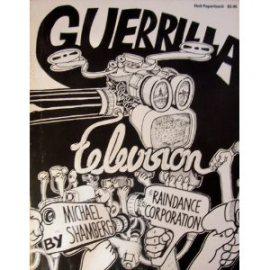
The collectives formed as a result of the first commercially available portable video recording system, the Sony Portapak, and it’s in the second half of Guerilla Television that Shamberg outlines how to use the camera to become a participant in media, not just an observer or subject. That is the real fight for the television guerilla, to create a diverse information environment in a time of heavy bias towards the broadcast studio establishment, the television of the “beast.”

One especially perspicacious attitude Shamberg strikes is the care with which the television guerilla must control their own media image. This why he never saw broadcast television as a suitable home for citizen produced video. “For perhaps one hour of exposure, once, at a pre-determined time, they will spend months organizing, contacting people, and having meetings.” Furthermore, video artists risked getting “caught,” being labeled by broadcast television in such a manner as to marginalize the message, ghettoizing the work into something akin to “Crazy Experimental Far-Out Videotape Makers.” As Shamberg saw it, this was the ultimate failing of the Black Panthers: they let themselves get caught.
“The moment you surrender control of your media image, you’re captured. This is what happened to the Black Panthers. White America very logically cut them down, both literally and figuratively, because the Panthers lacked the control they needed over media to get the non-belligerent, more constructive part of their message across (if they had one.)” (Shamberg 33, 1971)
As a friend and volunteer at the People’s Library in Zuccotti Park put it, this protest is probably the most well documented one in history. It’s certainly true; every other person at both encampments was taking pictures or recording video. But what happened to the footage? It ended up in a private collection, or uploaded on YouTube or Vimeo for other news organizations, right and left, to grab and contextualize any which way they like. As we’ve seen, these contextualizations are very rarely unequivocally positive. And while the OWS website featured large amounts of video and pictures, I think it’s still fair to say that the movement underestimated its ability to control its own media image.
It seems almost unfair to use two books written in 1971 to criticize a 2011 protest, but I think that speaks to how fundamental some of OWS’s flaws have been. It embraced too many fringe elements to make itself consistently relatable to anyone outside of a similar cultural background, and made too few, or too feeble, attempts to fight against how the mainstream media portrayed them. As a result, protest after protest has been cleared away and popular nationwide reactions have only ranged from glad to disappointed when there have should have been a singular voter-stoked righteous hellfire that sent every elected official involved cowering under his or her own desk.
It’s obviously not too late to adjust any of the problems I’ve described, and there are other solutions to prescribe. Without the permanent camps, I’d say that the public image of OWS has actually improved greatly, forcing observers to focus instead on the thousands who participate in marches like the one across the Brooklyn Bridge on November 17th, the two month anniversary of the occupation in Zuccotti. And Jon already discussed the potential benefits of a charismatic face for the movement; I am certainly in agreement (whomever the movement selects, if anyone, can be any worse than Ketchup). What I’ll add is the need for a hero outside of OWS, and for a fuller understanding of what exactly kind of hero that is, I turn to none other than Spider Jerusalem.
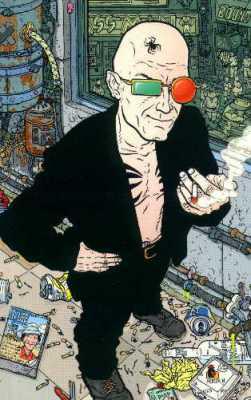
Pictured: The hero we need, but not the one we deserve
Transmetropolitan, written by Warren Ellis from 1997 to 2002, chronicled the adventures of the foul mouthed misanthropic gonzo journalist shown above as he fought on behalf of the people against governmental, financial and cultural corruption. Throughout the series the most exciting fights are his razor sharp interviews, and the most nail-biting climaxes feature him typing away on his laptop. “The truth, no matter what,” is Spider’s motto, and heaven help anyone who tries to stop him from exposing the truth.
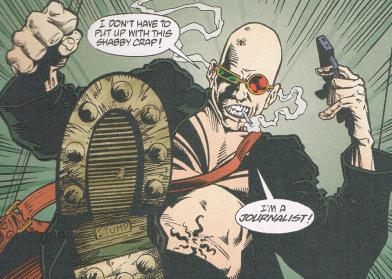
I think of him now because the inability of the bulk of this nation’s journalists to string together cogent analysis about OWS has been universally appalling, even with the barriers the movement itself set up between itself and the outside world. One would think that the mainstream media would have learned its lesson since the WMD fiasco in 2003, but recent events have shown it to not be the case, especially in light of willful media absence from the forced evacuations of OWS and other branches throughout the US. As you may recall, Bloomberg made damn sure that the press were blocked off from shooting anything near Zuccotti (again controlling the media narrative) when the NYPD swept through, and only a few brave journalists remembered their right to stand their ground.
Another occasion to remember Mr. Jerusalem: in one issue, he’s been assigned to cover a ghetto of genetically modified and generally despised under-25’s fighting for better treatment from the city’s government, the Civic Center. They blockade themselves in, but the police find an excuse for action by paying two drunken transients to start a fight. So in the name of public safety the police storm the ghetto while keeping all of the reporters back, again in the same of public safety. Sound familiar?
Of course Jerusalem sneaks in and reports on the riots and brutality from a rooftop, live feeding his article to the millions around the city who regularly read his column. It’s the kind of journalistic heroism this country and others now sorely miss, so much that it reads as much like science fiction as the rest of the story. But what’s more painful to read is how merciless he is in his ultimate condemnation of those responsible for the injustice he witnesses. I provide excerpts from his article captioned below.
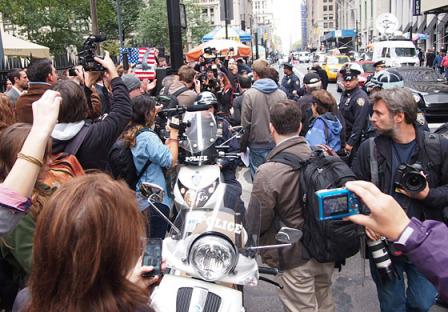
“If anyone in this shithole city gave two tugs of a dead dog’s cock about Truth, this wouldn’t be happening.”
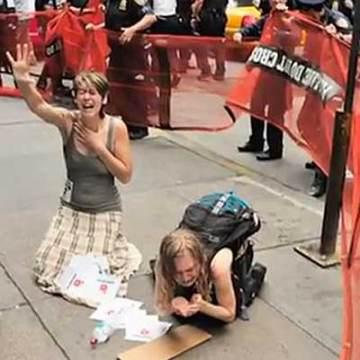
“No one’s eyes would be bleeding from incapacity sprays …”
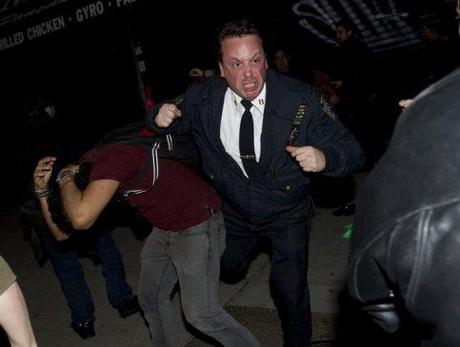
“Enjoying this? You like the way I describe disgusting shit happening to people you probably walked past in the street last week?”
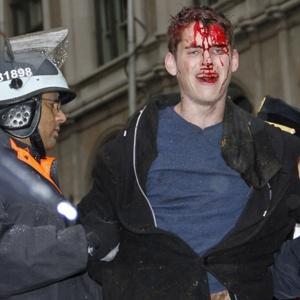
“Good. You earned it. With your silence.”
This is where my own article becomes difficult to write. I have been pointing out the weaknesses I see in OWS, suggesting remedies to this and that, but the truth is that I’m the failure. If I really gave as much of a shit as I say I do then I would have been down there contributing on the street instead of observing from a position of comfort, instead of sharing my opinions with other like-minded individuals before shaking my head in condescending disappointment. Like so many people keep repeating in a frustrated attempt to motivate the nation’s malcontent, I could have been the change I wanted to see. I could have gotten involved and in whatever possible capacity helped steer the movement to what I saw as more productive action.
But I didn’t. I sat on the sidelines. If OWS is destined for collapse, then I will have to take my responsibility in allowing it to happen. If this generation and the next remain fucked by the institutions being fought today, then I will have to beg on bended knee for forgiveness.
And if you’re reading this from an occupied city and know firsthand how I feel, then you will have to beg too.
Let’s all try to do better tomorrow.
[1] Remember, protestors were in Zuccotti Park a week before a single news camera showed up.
[2] Oakland Deputy Mayor Sharon Cornuis is the exception.

